1. 需求分析

(1)初始化查询条件下拉列表

(2)展示客户列表,并且可以根据查询条件过滤查询结果,并且实现分页处理。
(3)修改客户信息:
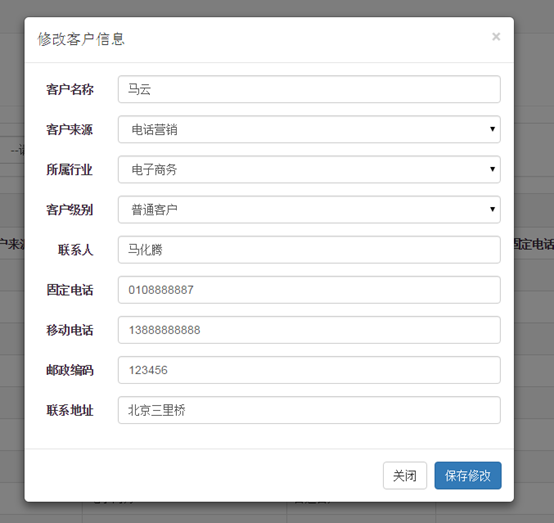
1)点击客户列表中的“修改”按钮弹出客户信息修改对话框,并初始化客户信息;
2)点击“保存修改”按钮将修改后的结果保存到数据库中。
(4)删除客户
点击客户列表中的删除按钮,提示“警告信息”:
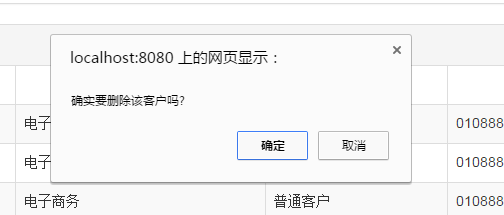
点击确定后删除用户信息,并刷新页面。
2. 数据库表

客户表customer:
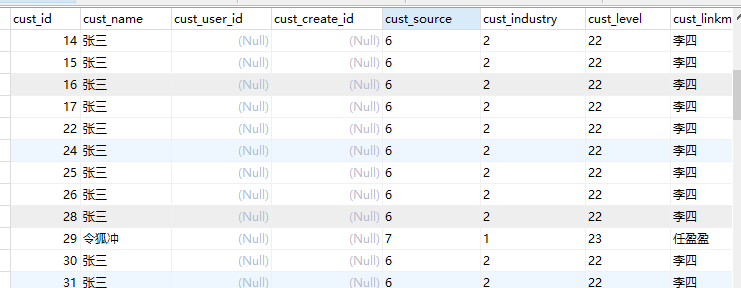
字典查询表base_dict:
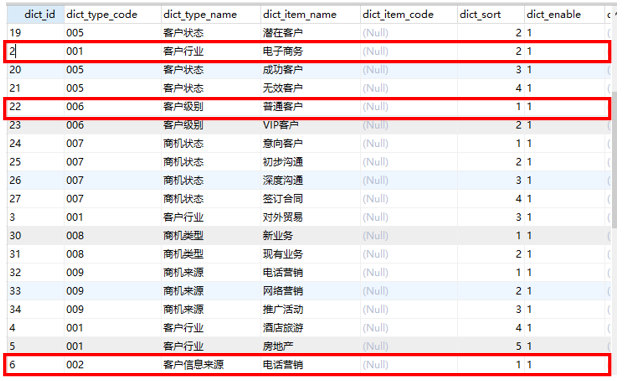
3. 工程搭建(SSM整合)
(1)Dao层
pojo和映射文件以及接口手动编写
SqlMapConfig.xml : mybatis核心配置文件
ApplicationContext-dao.xml 整合后spring在dao层的配置:数据源、会话工厂、扫描Mapper
(2)service层
事务 ApplicationContext-trans.xml@Service注解扫描 ApplicationContext-service.xml
(3)controller层
SpringMvc.xml :注解扫描:扫描@Controller注解
注解驱动:替我们显示的配置了最新版的处理器映射器和处理器适配器
视图解析器:显示的配置是为了在controller中不用每个方法都写页面的全路径
(4)web.xml
springMvc前端控制器配置
spring监听
java类结构:
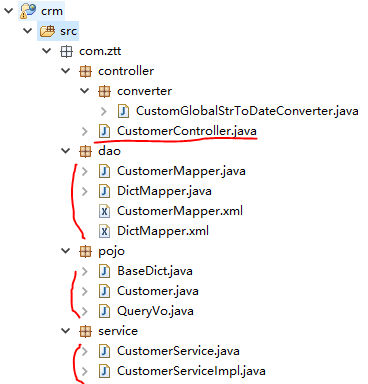
Springmvc、spring、mybatis框架整合:
所有配置文件放在一个config文件夹内,注意config要建成源文件夹(右键src --> new --> Source Folder),这样就可以直接用 classpath:指向要访问的这几个文件(因为源文件夹最后都会被加到classes目录里)。
(1)SqlMapConfig.xml :(不写内容)
<?xml version="1.0" encoding="UTF-8" ?> <!DOCTYPE configuration PUBLIC "-//mybatis.org//DTD Config 3.0//EN" "http://mybatis.org/dtd/mybatis-3-config.dtd"> <configuration> </configuration>
(2)ApplicationContext-dao.xml :整合后spring在dao层的配置:数据源、会话工厂、扫描Mapper
<!-- 加载配置文件 --> <context:property-placeholder location="classpath:db.properties" /> <!-- 数据库连接池 --> <bean id="dataSource" class="com.alibaba.druid.pool.DruidDataSource" destroy-method="close"> <property name="driverClassName" value="${jdbc.driver}" /> <property name="url" value="${jdbc.url}" /> <property name="username" value="${jdbc.username}" /> <property name="password" value="${jdbc.password}" /> </bean> <!-- mapper配置 --> <!-- 让spring管理sqlsessionfactory 使用mybatis和spring整合包中的 --> <bean id="sqlSessionFactory" class="org.mybatis.spring.SqlSessionFactoryBean"> <!-- 数据库连接池 --> <property name="dataSource" ref="dataSource" /> <!-- 加载mybatis的全局配置文件 --> <property name="configLocation" value="classpath:SqlMapConfig.xml" /> </bean> <!-- 配置Mapper扫描器 --> <bean class="org.mybatis.spring.mapper.MapperScannerConfigurer"> <property name="basePackage" value="com.ztt.dao"/> </bean>
(3)ApplicationContext-service.xml :配置@Service注解扫描
<!-- @Service扫描 --> <context:component-scan base-package="com.ztt.service"></context:component-scan>
(4)ApplicationContext-trans.xml :配置事务
<!-- 事务管理器 --> <bean id="transactionManager" class="org.springframework.jdbc.datasource.DataSourceTransactionManager"> <!-- 数据源 --> <property name="dataSource" ref="dataSource" /> </bean> <!-- 通知 --> <tx:advice id="txAdvice" transaction-manager="transactionManager"> <tx:attributes> <!-- 传播行为 --> <tx:method name="save*" propagation="REQUIRED" /> <tx:method name="insert*" propagation="REQUIRED" /> <tx:method name="delete*" propagation="REQUIRED" /> <tx:method name="update*" propagation="REQUIRED" /> <tx:method name="find*" propagation="SUPPORTS" read-only="true" /> <tx:method name="get*" propagation="SUPPORTS" read-only="true" /> </tx:attributes> </tx:advice> <!-- 切面 --> <aop:config> <aop:advisor advice-ref="txAdvice" pointcut="execution(* com.ztt.service.*.*(..))" /> </aop:config>
【注】ApplicationContext-dao.xml 、ApplicationContext-service.xml、ApplicationContext-trans.xml也可以写到一个ApplicationContext.xml中。
(5)SpringMvc.xml:(MyBatis的配置文件),配置@Controller注解扫描、注解驱动(处理映射器和处理适配器)、视图解析器。
<!-- @Controller注解扫描 --> <context:component-scan base-package="cn.ztt.controller"></context:component-scan> <!-- 注解驱动: 替我们显示的配置了最新版的注解的处理器映射器和处理器适配器 --> <mvc:annotation-driven conversion-service="conversionService"></mvc:annotation-driven> <!-- 配置视图解析器 作用:在controller中指定页面路径的时候就不用写页面的完整路径名称了,可以直接写页面去掉扩展名的名称 --> <bean class="org.springframework.web.servlet.view.InternalResourceViewResolver"> <!-- 真正的页面路径 = 前缀 + 去掉后缀名的页面名称 + 后缀 --> <!-- 前缀 --> <property name="prefix" value="/WEB-INF/jsp/"></property> <!-- 后缀 --> <property name="suffix" value=".jsp"></property> </bean>
<!-- 配置自定义转换器 注意: 一定要将自定义的转换器配置到注解驱动上 --> <bean id="conversionService" class="org.springframework.format.support.FormattingConversionServiceFactoryBean"> <property name="converters"> <set> <!-- 指定自定义转换器的全路径名称 CustomerGlobalStrToDataConverter是我们自己写的一个类,实现日期转换--> <bean class="com.ztt.controller.converter.CustomGlobalStrToDateConverter"/> </set> </property> </bean>
(6)Web.xml:配置spring监听、springmvc前端控制器(拦截所有.action文件)、Post请求乱码
<!-- 加载spring容器 --> <context-param> <param-name>contextConfigLocation</param-name> <param-value>classpath:ApplicationContext-*.xml</param-value> </context-param>
<!-- Spring监听器 -->
<listener> <listener-class>org.springframework.web.context.ContextLoaderListener</listener-class> </listener> <!-- springmvc前端控制器 --> <servlet> <servlet-name>springMvc</servlet-name> <servlet-class>org.springframework.web.servlet.DispatcherServlet</servlet-class> <init-param> <param-name>contextConfigLocation</param-name> <param-value>classpath:SpringMvc.xml</param-value> </init-param> <!-- 在tomcat启动的时候就加载这个servlet --> <load-on-startup>1</load-on-startup> </servlet> <servlet-mapping> <servlet-name>springMvc</servlet-name> <!-- *.action 代表拦截后缀名为.action结尾的 / 拦截所有但是不包括.jsp /* 拦截所有包括.jsp --> <url-pattern>*.action</url-pattern> </servlet-mapping> <!-- 配置Post请求乱码 --> <filter> <filter-name>CharacterEncodingFilter</filter-name> <filter-class>org.springframework.web.filter.CharacterEncodingFilter</filter-class> <init-param> <param-name>encoding</param-name> <param-value>utf-8</param-value> </init-param> </filter> <filter-mapping> <filter-name>CharacterEncodingFilter</filter-name> <url-pattern>/*</url-pattern> </filter-mapping>
(7)加入jsp:
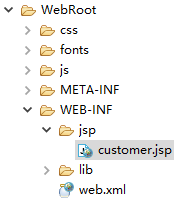
4. 实现1:查询条件初始化

- 客户来源、所属行业、客户级别分别对象表base_dict中的 dict_type_code=002、001、006
实际操作中我们不要传入这些模糊数字,可以建一个properties资源文件,然后将这些数字与所代表的含义通过 键-值映射 存储。
建立resource.properties资源文件:
customer.dict.source=002
customer.dict.industry=001
customer.dict.level=006
然后在 SpringMvc中引入该文件:
<!-- 引入字典资源文件 --> <context:property-placeholder location="classpath:resource.properties"/>
由controller层调用service层,service层调用dao层,dao层来操作数据库 。下面由DAO->service->controler我们来编写代码:
(1)DAO层
cn.ztt.dao包下 :(一个表对应一个mapper,我们用customer、base_dict这两个表,所以建2个mapper)
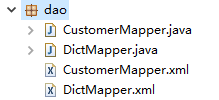
1)DictMapper.xml 编写数据库查询:
<?xml version="1.0" encoding="UTF-8" ?> <!DOCTYPE mapper PUBLIC "-//mybatis.org//DTD Mapper 3.0//EN" "http://mybatis.org/dtd/mybatis-3-mapper.dtd" > <mapper namespace="com.ztt.dao.DictMapper"> <select id="findDictByCode" parameterType="String" resultType="com.ztt.pojo.BaseDict"> select * from base_dict b where b.dict_enable=1 and b.dict_type_code=#{code} order by b.dict_sort </select> </mapper>
2)DictMapper接口 上定义 findDictByCode 方法
public interface DictMapper { public List<BaseDict> findDictByCode(String code); }
(2)service层

3)在service层实现 findDictByCode 方法:
先在CustomerService(接口)上编写 findDictByCode 方法
public interface CustomerService { public List<BaseDict> findDictByCode(String code); }
然后在 CustomerServiceImpl 实现类上实现该方法。注意类上要加@Service注解:
@Service public class CustomerServiceImpl implements CustomerService { //因为下面要调用DAO的方法,所以把DAO层的DictMapper传进来 @Autowired private DictMapper dictMapper; @Override public List<BaseDict> findDictByCode(String code) { List<BaseDict> list = dictMapper.findDictByCode(code); return list; } }
(3)Controller层
4)在 CustomerController.java类上调用service层的方法实现:
@Controller @RequestMapping("/customer") public class CustomerController { @Autowired private CustomerService customerService; //读取resource.properties中的键并设置名称 @Value("${customer.dict.source}") private String source; @Value("${customer.dict.industry}") private String industry; @Value("${customer.dict.level}") private String level; //接收QueryVo对象是为了数据回显,接收Model是为了向页面传入参数 @RequestMapping("/list") public String list(QueryVo vo, Model model) throws Exception { //客户来源 List<BaseDict> sourceList = customerService.findDictByCode(source); //客户行业 List<BaseDict> industryList = customerService.findDictByCode(industry); //客户级别 List<BaseDict> levelList = customerService.findDictByCode(level); //发送的是get请求,这里要处理get请求乱码,没有解决! /*if(vo.getCustName() != null){ vo.setCustName(new String(vo.getCustName().getBytes("iso8859-1"),"utf-8")); }*/ //将信息响应给页面, 页面上分别使用${fromType}、${industryType}、${levelType}接收 //高级查询下拉列表数据 model.addAttribute("fromType", sourceList); model.addAttribute("industryType", industryList); model.addAttribute("levelType", levelList); //QueryVo中封装了custName、custSource、custIndustry、custLevel这几个属性 //高级查询选中数据回显 model.addAttribute("custName", vo.getCustName()); model.addAttribute("custSource", vo.getCustSource()); model.addAttribute("custIndustry", vo.getCustIndustry()); model.addAttribute("custLevel", vo.getCustLevel());
return "customer"; } }
上面采用 vo.setCustName(new String(vo.getCustName().getBytes("iso8859-1"),"utf-8")); 的方法没有解决乱码问题:
在输入中文后中文变成了问号:
后来选了另一种方式解决:直接修改tomcat的编码方式:在conf文件夹下的server.xml 文件里指定编码格式为UTF-8
<Connector port="8275" protocol="HTTP/1.1" connectionTimeout="20000" maxHttpHeaderSize ="10240" redirectPort="8443"URIEncoding="UTF-8"/>
5. 实现2:展示客户列表,并且可以根据查询条件过滤查询结果,并且实现分页处理
首先看下 QueryVo类 :
public class QueryVo { private String custName; //客户名称 private String custSource; //客户来源 private String custIndustry;//客户行业 private String custLevel; //客户级别 //分页属性 private Integer page = 1; //当前第几页,默认是第1页 private Integer start; //这一页从第几个记录开始 private Integer size = 10; //一页有几条记录,默认10条 set/get....... }
在得到查询条件后,我们传入QueryVo对象进行客户列表查询。
(1)DAO层
1)CustomerMapper.xml 编写数据库查询 :
根据QueryVo对象编写 findCustomerByVo(查询客户列表)、findCustomerByVoCount(查询客户数):
<?xml version="1.0" encoding="UTF-8" ?> <!DOCTYPE mapper PUBLIC "-//mybatis.org//DTD Mapper 3.0//EN" "http://mybatis.org/dtd/mybatis-3-mapper.dtd" > <mapper namespace="com.ztt.dao.CustomerMapper"> <sql id="customer_where"> <where> <if test="custName != null and custName != ''"> and a.cust_name like '%${custName}%' </if> <if test="custSource != null and custSource != ''"> and a.cust_source=#{custSource} </if> <if test="custIndustry != null and custIndustry != ''"> and a.cust_industry=#{custIndustry} </if> <if test="custLevel != null and custLevel != ''"> and a.cust_level=#{custLevel} </if> </where> </sql> <select id="findCustomerByVo" parameterType="com.ztt.pojo.QueryVo" resultType="com.ztt.pojo.Customer"> select a.cust_id,a.cust_name, b.dict_item_name cust_source, c.dict_item_name cust_industry, d.dict_item_name cust_level,a.cust_phone,a.cust_mobile, a.cust_linkman, a.cust_zipcode, a.cust_address, a.cust_createtime from customer a left join base_dict b on a.cust_source = b.dict_id left join base_dict c on a.cust_industry = c.dict_id left join base_dict d on a.cust_level = d.dict_id <include refid="customer_where"></include> limit #{start}, #{size} </select> <select id="findCustomerByVoCount" parameterType="com.ztt.pojo.QueryVo" resultType="int"> select count(*) from customer a left join base_dict b on a.cust_source = b.dict_id left join base_dict c on a.cust_industry = c.dict_id left join base_dict d on a.cust_level = d.dict_id <include refid="customer_where"></include> </select> </mapper>
2) DictMapper类 上定义 findCustomerByVo、findCustomerByVoCount方法:
public interface CustomerMapper { //查询客户列表 public List<Customer> findCustomerByVo(QueryVo vo); //查询客户人数 public Integer findCustomerByVoCount(QueryVo vo); }
(2)Service层
3)在service层实现 findCustomerByVo、findCustomerByVoCount方法:
先在CustomerService(接口)上编写 findCustomerByVo、findCustomerByVoCount 方法
public List<Customer> findCustomerByVo(QueryVo vo); public Integer findCustomerByVoCount(QueryVo vo);
然后在 CustomerServiceImpl 实现类上实现这两个方法:
@Service public class CustomerServiceImpl implements CustomerService { @Autowired private DictMapper dictMapper; @Autowired private CustomerMapper customerMapper; @Override public List<BaseDict> findDictByCode(String code) { List<BaseDict> list = dictMapper.findDictByCode(code); return list; } @Override public List<Customer> findCustomerByVo(QueryVo vo) { List<Customer> list = customerMapper.findCustomerByVo(vo); return list; } @Override public Integer findCustomerByVoCount(QueryVo vo) { Integer count = customerMapper.findCustomerByVoCount(vo); return count; } }
(3)Controller层
4)在 CustomerController.java类上调用service层的方法实现:
@Controller @RequestMapping("/customer") public class CustomerController { @Autowired private CustomerService customerService; //读取resource.properties中的键并设置名称 @Value("${customer.dict.source}") private String source; @Value("${customer.dict.industry}") private String industry; @Value("${customer.dict.level}") private String level; //接收QueryVo对象是为了数据回显,接收Model是为了向页面传入参数 @RequestMapping("/list") public String list(QueryVo vo, Model model) throws Exception { //客户来源 List<BaseDict> sourceList = customerService.findDictByCode(source); //客户行业 List<BaseDict> industryList = customerService.findDictByCode(industry); //客户级别 List<BaseDict> levelList = customerService.findDictByCode(level); //默认当前页为1 if(vo.getPage() == null){ vo.setPage(1); } //设置查询的起始记录条数 vo.setStart((vo.getPage() - 1) * vo.getSize());
//查询数据列表和数据总数 List<Customer> resultList = customerService.findCustomerByVo(vo); Integer count = customerService.findCustomerByVoCount(vo);
//page是我们自己写的封装分页的类,将查询结果封装到该类中 Page<Customer> page = new Page<Customer>(); page.setTotal(count); //数据总数 page.setSize(vo.getSize());//每页显示条数 page.setPage(vo.getPage());//当前页数 page.setRows(resultList); //数据列表 //将查询结果返回给页面 model.addAttribute("page", page);
//将信息响应给页面, 页面上分别使用${fromType}、${industryType}、${levelType}接收 //高级查询下拉列表数据 model.addAttribute("fromType", sourceList); model.addAttribute("industryType", industryList); model.addAttribute("levelType", levelList); //QueryVo中封装了custName、custSource、custIndustry、custLevel这几个属性 //高级查询选中数据回显 model.addAttribute("custName", vo.getCustName()); model.addAttribute("custSource", vo.getCustSource()); model.addAttribute("custIndustry", vo.getCustIndustry()); model.addAttribute("custLevel",vo.getCustLevel());
return "customer"; } }
效果:

6.实现3:修改客户信息
6.1 点击客户列表中的“修改”按钮弹出客户信息修改对话框,并初始化客户信息:
思路:一点击修改就提交controller,交给controller一个id(这条记录的id),然后根据这条记录的id查询这条记录的详细信息,把数据返回回来。
(1)DAO层:
在 CustomerMapper.xml 编写 根据id查询用户信息的sql语句:
<select id="findCustomerById" parameterType="long" resultType="com.ztt.pojo.Customer"> select * from customer where cust_id=#{id} </select>
在CustomerMapper.java 接口编写 findCustomerById 方法:
//根据id查询客户信息 public Customer findCustomerById(Long id);
(2)Service层:
先在CustomerService(接口)上编写 findCustomerBId 方法:
public Customer findCustomerById(Long id);
然后在CustomerServiceImpl 实现类上实现这个方法:
@Autowired private CustomerMapper customerMapper; @Override public Customer findCustomerById(Long id) { Customer customer = customerMapper.findCustomerById(id); return customer; }
(3)Controller层:
@Autowired private CustomerService customerService; @RequestMapping("/detail") @ResponseBody //将Java类自动转为json数据 public Customer detail(Long id) throws Exception{ Customer customer = customerService.findCustomerById(id); return customer; }
customer.jsp相对应的:
。。。。。。
<a href="#" 。。。。。。 onclick="editCustomer(${row.cust_id})">修改</a>
。。。。。。
<script type="text/javascript"> function editCustomer(id) { $.ajax({ type:"get", url:"<%=basePath%>customer/detail.action", data:{"id":id}, success:function(data) { $("#edit_cust_id").val(data.cust_id); $("#edit_customerName").val(data.cust_name); $("#edit_customerFrom").val(data.cust_source) $("#edit_custIndustry").val(data.cust_industry) $("#edit_custLevel").val(data.cust_level) $("#edit_linkMan").val(data.cust_linkman); $("#edit_phone").val(data.cust_phone); $("#edit_mobile").val(data.cust_mobile); $("#edit_zipcode").val(data.cust_zipcode); $("#edit_address").val(data.cust_address); } }); }
</script>
效果:点击修改后弹出客户信息修改对话框,并初始化了客户信息:
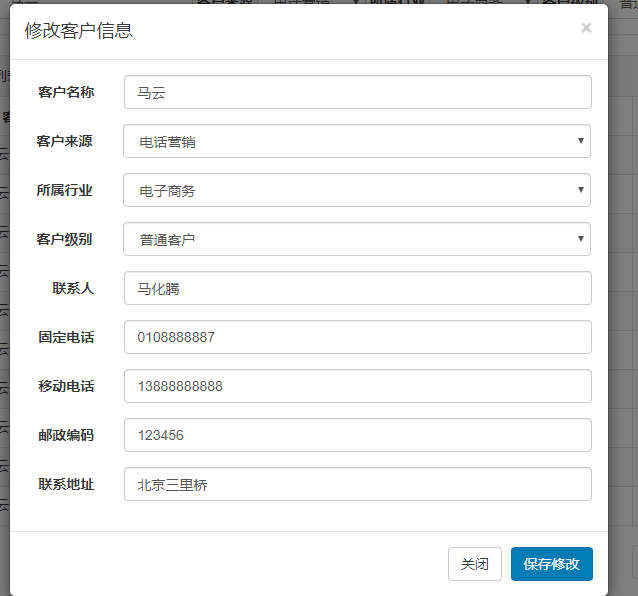
6.2 点击“保存修改”按钮将修改后的结果保存到数据库中。
(1)DAO层:
在 CustomerMapper.xml 编写 修改 的sql语句:
<update id="updateCustomerById" parameterType="com.ztt.pojo.Customer"> update customer <!-- set标签作用:第一可以自动添加set关键字, 第二可以去掉最后一个更新的逗号 --> <set> <if test="cust_name != null and cust_name != ''"> cust_name=#{cust_name} , </if> <if test="cust_source != null and cust_source != ''"> cust_source=#{cust_source}, </if> <if test="cust_industry != null and cust_industry != ''"> cust_industry=#{cust_industry}, </if> <if test="cust_level != null and cust_level != ''"> cust_level=#{cust_level}, </if> <if test="cust_linkman != null and cust_linkman != ''"> cust_linkman=#{cust_linkman}, </if> <if test=" cust_phone != null and cust_phone != ''"> cust_phone=#{cust_phone}, </if> <if test="cust_mobile != null and cust_mobile != ''"> cust_mobile=#{cust_mobile}, </if> <if test="cust_zipcode != null and cust_zipcode != ''"> cust_zipcode=#{cust_zipcode}, </if> <if test="cust_address != null and cust_address!= ''"> cust_address=#{cust_address}, </if> </set> where cust_id=#{cust_id} </update>
在CustomerMapper.java 接口编写 updateCustomerById 方法:
//修改客户信息 public void updateCustomerById(Customer customer);
(2)Service层:
先在CustomerService(接口)上编写 updateCustomerById 方法
public void updateCustomerById(Customer customer);
然后在CustomerServiceImpl 实现类上实现这个方法:
@Autowired private CustomerMapper customerMapper; @Override public void updateCustomerById(Customer customer) { customerMapper.updateCustomerById(customer); }
(3)Controller层:
@Autowired private CustomerService customerService; @RequestMapping("/update") public String update(Customer customer) throws Exception{ customerService.updateCustomerById(customer); //前端是ajax的请求,这边返回响应response,把“customer”当成一个页面,页面的所有内容当成字符串返回回去 return "customer"; }
customer.jsp相对应的:
。。。。。。
<button type="button" class="btn btn-primary" onclick="updateCustomer()">保存修改</button> 。。。。。。 <script type="text/javascript"> function updateCustomer() { $.post("<%=basePath%>customer/update.action",$("#edit_customer_form").serialize(),function(data){ alert("客户信息更新成功!"); window.location.reload();//页面重载 }); } </script>
7. 实现3:删除客户

思路:和修改类似,提交到 controller 的是所选记录的 id
(1)DAO层:
在 CustomerMapper.xml 编写 删除用户信息 的sql语句
<delete id="deleteCustomerById" parameterType="long"> delete from customer where cust_id=#{id} </delete>
在CustomerMapper.java 接口编写deleteCustomerById方法:
//删除用户信息 public void deleteCustomerById(Long id);
(2)Service层:
先在CustomerService(接口)上编写 deleteCustomerById 方法:
public void deleteCustomerById(Long id);
然后在CustomerServiceImpl 实现类上实现这个方法:
@Autowired private CustomerMapper customerMapper; @Override public void deleteCustomerById(Long id) { customerMapper.deleteCustomerById(id); }
(3)Controller层:
@Autowired private CustomerService customerService; @RequestMapping("/delete") public String delete(Long id) throws Exception{ customerService.deleteCustomerById(id); return "customer"; }
customer.jsp相对应的:
。。。。。。 <a href="#" class="btn btn-danger btn-xs" onclick="deleteCustomer(${row.cust_id})">删除</a> 。。。。。。 <script type="text/javascript"> function deleteCustomer(id) { if(confirm('确实要删除该客户吗?')) { $.post("<%=basePath%>customer/delete.action",{"id":id},function(data){ alert("客户删除更新成功!"); window.location.reload(); }); } } </script>
